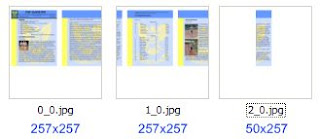These two simple examples shows how 'Mermaid' thinks: it will fill up tiles from top-left, leaving the bottom-right tiles "just" big enough to encapsulate the source image.


That's fine for Silverlight 2.0
MultiScaleImage controls to work with, since it can 'cheat' during layout, using the data in info.bin/info.xml to figure out how many Image controls to dynamically create.
But for a basic tile-client (of the sort that can easily display map tiles) that expects the source data to be a perfect square, the basic 'Mermaid' output is "too efficient".
Enter the MakeSquare console application...

It needs a little bit of 'tuning' (the "base" zoom level is hardcoded), but it basically walks a DeepZoom Composer output directory and
- makes all tiles square
- fills in missing tiles to make each 'zoom level' square
No comments:
Post a Comment
Note: only a member of this blog may post a comment.